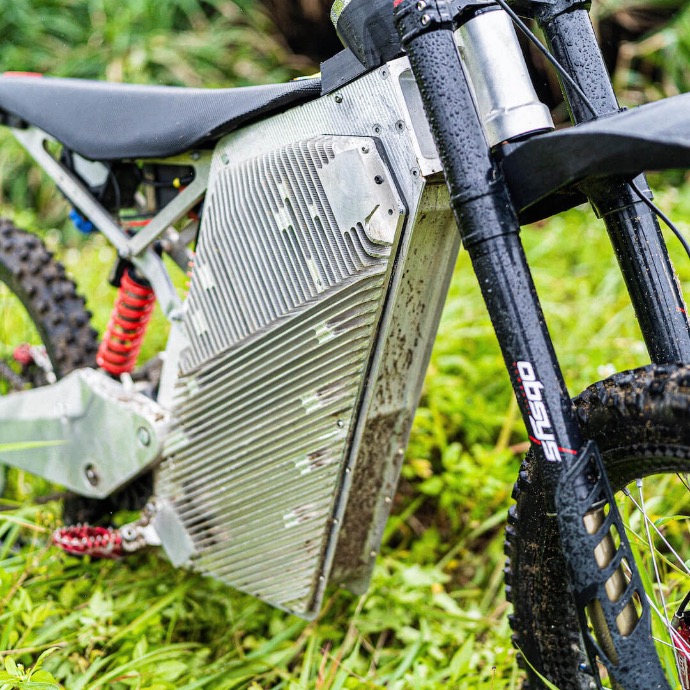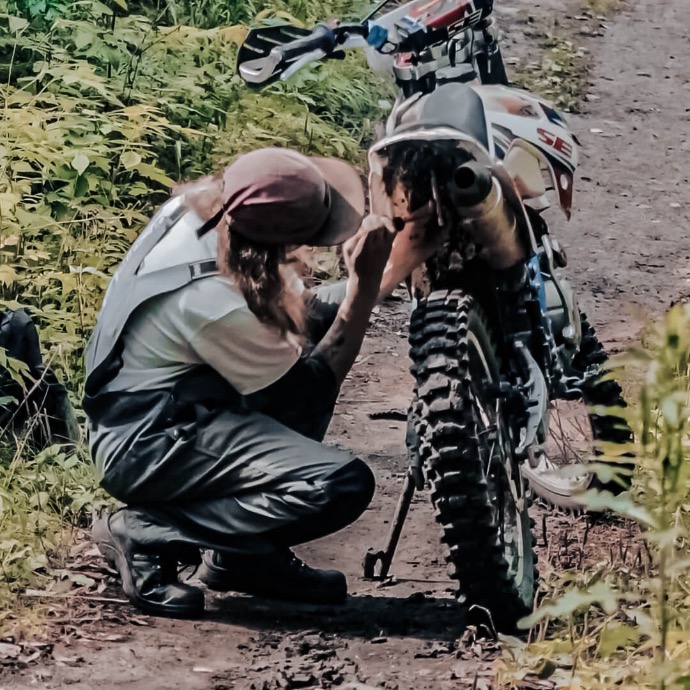Graft founder Azizi Tucker grew up riding off road and mountain bikes, including racing mountain bikes competitively into his 20s. These decades of experience afforded him the chance to understand the progression a rider goes through from the beginning stages and evolving into a more advanced rider. Accordingly, at Graft we have taken to referring to motorbike riders on a skill scale of 0-10, with 0 being someone who is just trying it for the very first time and 10 being a pro motocross athlete. Most electric motorbikes are only accessible for riders in the 0-4 range. Conversely, it’s all too common to see amateur riders struggling to control the large, powerful 450 cc gas-powered bikes driven by Jeremy McGrath and their other motocross heroes. Our goal is to strike a balance. The EO.12 is intended to be suitable for beginners as well as very experienced riders, and the design and features allow the beginner to grow along with the bike, keeping the bike valuable and level-appropriate for many years.

Using the Gas Bike as a Model
As mentioned above, it’s possible to buy the same model of motorbikes that some of the top pros in the world ride, and dealers often shamelessly sell and even promote these bikes to less experienced riders. While we all want to ride the same bike as James Steward and these other heroes that we grew up watching, the reality is that those bikes are not a good fit for most riders. Several aspects of these bikes can present challenges to casual riders, including seat height, power, weight, torque characteristics, and even maintenance. Understanding this, we have rethought the way a bike is designed to improve the ride and overall user experience.
While we've designed the bike to be great for beginner and intermediate riders, the EO.12 offers 18 to 20 KW of power with a weight of just 50 kg, giving the equivalent performance of about a 300 cc motocross bike. So we offer the same level of performance at the top end as some of the most powerful gas-powered bikes on the market, while being able to reduce the power and a weight that makes the bike an easy entry point for beginners and very manageable for weekend riders who are frequently loading and unloading their bikes.
As you can see, user experience and technology are the driving factors in the design process at Graft. We not only think comparatively about rider experiences on gas bikes and other electric bikes, but also consider the capabilities of our electric drive trains and other components. We have spent hundreds of hours considering how and where riders will use our bikes and then test riding in all kinds of environmental and weather conditions. All of this empirical evidence has gone into the EO.12, from the battery life to the seat height to the tires and more.

What Do We Mean by Pros vs. Joes?
Put simply, a pro doesn't have a day job. Motorcycling or motocross or enduro riding is their job and they are riding and training every day. That rider’s focus is on nutrition, strength, weight training and tactical riding. But the vast majority of people who ride off road bikes have a day job, need to be at work on Monday morning, don't have time to train 5-6 days a week, and want to avoid injuries that will eliminate their ability to take part in the sport they love. This is us, we’re Joes. So we’ve set out to design and build bikes for people who have a day job but love to get out on the weekends and want to ride really hard, but need to be back in the office on Monday.
Leveling Up with the Bike
One thing we wanted to be sure of is that our vehicles are not a type that a rider or driver will quickly outgrow. So we’ve designed the vehicles in such a way that they can work well for beginners, but at the same time, the EO.12 for example, would be perfectly capable for an amateur-level race. We see a lot of bikes on the market, particularly in the electric market where the bikes are very small, have cramped ergonomics, and require significant modifications just to have a bike that will survive a typical trail ride, not to mention an amateur race. We design our bikes to a higher level so that a beginner can gain skills and enter this bike in an amateur race, and it'll live for years and years with heavy use on the trail.
The exceptional light weight of the EO.12 is another key feature that makes riding and training on this bike accessible to most riders. With a total weight of 50 kg, the bike is never intimidating and it's easy to handle on tricky terrain, but it still comes standard with carbon fiber wheels, our oversized brake system, our 42 mm inverted fork for the stiffness and kind of performance that's needed even for amateur racing. In addition to improving performance, this light weight allows many owners to load the bike on a rack or in the back of a truck by themselves, making transport and storage far easier than with a heavy, unwieldy gas bike.
As mentioned in the opening, some of our competitors’ bikes really only cover skillsets from about levels 0-4. Once a rider reaches a certain level of aptitude, they would be making elaborate and expensive changes to the specifications of the bike just to keep the bike at a level where they can keep improving. At the end of the day, after you've made all those changes, you still have a frame that was designed for just 5 KW of power, and that’s a problem. Conversely, we can confidently say that on our 0-10 scale, our bike covers the range of skills from zero to eight or nine.

How We Design for Joes
Vehicles are complex machines and therefore it’s not a matter of simply making one or two changes to a design that will make the machine more accessible or user-appropriate. For the EO.12 motorbike, specifically, we have made a number of intentional design and manufacturing choices in order to create a user experience and ride that both allows a beginner to get their bearings and offers a fun and aggressive trail experience for more experienced riders.

As we developed the EO.12, one of the things we wanted to do was to start with a clean sheet and not say we want to copy KTM or Honda or Yamaha or Kawasaki when it came to building a motorcycle. We looked at their enduro and motocross bikes and noticed the remarkably high seat, which offered amazing ground clearance but hurts maneuverability and ,oftentimes didn't give the user the confidence to use all the bike’s capabilities, particularly as terrain gets trickier. A really tall seat can be intimidating when you know you're not going to be able to get 1 or both feet down.
The EO.12 has a lower seat, which means the rider is going to have confidence even on very tricky terrain that they can always manage the bike. We're able to offer a full size motorcycle seat, which allows you to move your body to tackle steep up- and downhills, full-size motorcycle handlebars and oversized brakes to give you that control and confidence when you're riding on the difficult terrain.
Weight is another major consideration for our use experience. A typical enduro motocross bike is so heavy that it quickly tires riders out on tricky terrain. Knowing that we were doing an electric bike and that the power characteristics and range would be very different, we asked ourselves: how do we build the best possible electric off road bike? The key was to not copy gasoline bikes. We started with the ultralight target weight of just 50 kg. At this weight, less experienced riders can ride in a more dynamic way because they can use less energy to move the bike around and get over obstacles. Generally speaking, we also are preventing many of the injuries that you see on some heavier bikes. If you ride off a difficult obstacle and the bike falls on you, most times with 50 kg you can lift the bike off with one hand.


One things many typically notice about our bike is the wheel size. We have 21” tires in the front and rear. We're the only company in the market to offer a 21” rear tire. This size tire creates very low rolling resistance, which helps make the best of our battery range, and provides amazing hill climb traction at our 50 kg weight. This level of hill climb traction normally wouldn't be possible, but because we have very smooth power delivery with the electric drivetrain, we have more than enough traction with a relatively narrow tire. Using a narrower tire than a typical 18”, very wide tire means we save weight, which again pays off in riding range. And one more change we made was to offer a very high torque of over 400 Newton meters on the rear wheel, which means hill starts are no longer an issue, no playing with the clutch, just explosive torque for climbing. With three modes to choose from, you have the ability to reduce the torque when necessary.
The last thing we saw is as the performance of traditional gasoline and enduro bikes climbs, the maintenance needs climb apace. Typical off road gasoline bikes are going to require about one hour of maintenance per ride, whether that's lubricating chains, cleaning air filters, draining fuel, or changing oil. That oftentimes can be the same amount of time you’re out riding. So with our fully electric bike, we're able to reduce that maintenance time to virtually zero, setting the rider free to enjoy the ride.

Joes Know Riding
While anyone can go out and buy Lebron James’ shoes, then go to the basketball court and have essentially the same experience they would have the day before, the same simply isn’t true of a motorbike. It’s possible to go out and buy a 450 cc motorcross bike, but the truth is that your experience on a bike like that isn’t likely to be as rewarding as you envision. In the same way that we have designed our battery packs to extend the life (and the rides) of our vehicles, we have thoughtfully designed many other aspects of our machines so that they will sustain their value and utility for riders across the skills spectrum for years and years of trails and tracks.